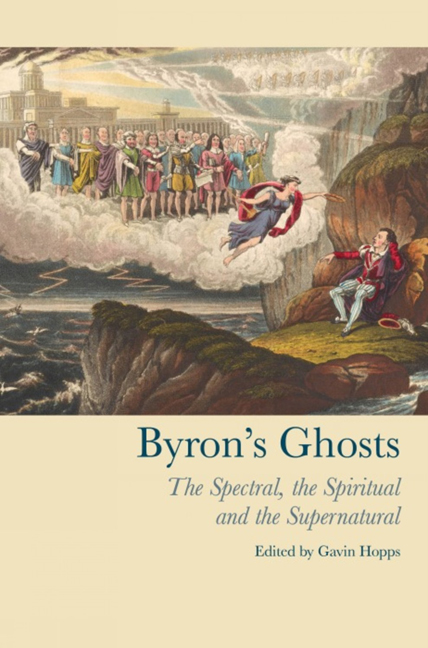Book contents
- Frontmatter
- Dedication
- Contents
- Acknowledgements
- Texts and Abbreviations
- Introduction: The Re-Enchantment of Romanticism
- Chapter 1 Determining Unknown Modes of Being: A Map of Byron's Ghosts and Spirits
- Chapter 2 Shades of Being: Byron and the Trespassing of Ontology
- Chapter 3 Byron and the Noonday Demons
- Chapter 4 Conjuration and Exorcism: Byron's Spectral Rhetoric
- Chapter 5 Byron avec Sade: Material and Spectral Violence in Childe Harold's Pilgrimage Canto IV
- Chapter 6 ‘’Twixt Life and Death’: Childe Harold's Pilgrimage, Don Juan and the Sublime
- Chapter 7 Byron, Ann Radcliffe and the Religious Implications of the Explained Supernatural in Don Juan
- Chapter 8 The Haunting of Don Juan
- Chapter 9 Being neither Here nor There: Byron and the Art of Flirtation
- Afterword: Blowing on a Dead Man's Embers: Byron's Biographical Ghosts
- Bibliography
- Notes on Contributors
- Index
Chapter 7 - Byron, Ann Radcliffe and the Religious Implications of the Explained Supernatural in Don Juan
- Frontmatter
- Dedication
- Contents
- Acknowledgements
- Texts and Abbreviations
- Introduction: The Re-Enchantment of Romanticism
- Chapter 1 Determining Unknown Modes of Being: A Map of Byron's Ghosts and Spirits
- Chapter 2 Shades of Being: Byron and the Trespassing of Ontology
- Chapter 3 Byron and the Noonday Demons
- Chapter 4 Conjuration and Exorcism: Byron's Spectral Rhetoric
- Chapter 5 Byron avec Sade: Material and Spectral Violence in Childe Harold's Pilgrimage Canto IV
- Chapter 6 ‘’Twixt Life and Death’: Childe Harold's Pilgrimage, Don Juan and the Sublime
- Chapter 7 Byron, Ann Radcliffe and the Religious Implications of the Explained Supernatural in Don Juan
- Chapter 8 The Haunting of Don Juan
- Chapter 9 Being neither Here nor There: Byron and the Art of Flirtation
- Afterword: Blowing on a Dead Man's Embers: Byron's Biographical Ghosts
- Bibliography
- Notes on Contributors
- Index
Summary
At first sight, it may seem somewhat comical to associate the sceptical and famously transgressive Lord Byron with the productions of a middle-class novelist of non-conformist origins, who classed protagonists of his aristocratic arrogance and incestuous predilections alongside her darkest villains. And yet in proposing a Radcliffean Gothic structure to the ghost scenes of Canto XVI of Byron's unfinished epic, Don Juan, I hope to find a way both to explicate the complex nature of the poet's attitude to the transcendent and to clarify the overall philosophical trajectory of his poem. In suggesting that the explained supernatural is used by Byron to trace a middle path between idealism and a dead materialism, I also hope to mediate between the Christian idealism of Bernard Beatty's interpretation of these English Cantos and those, like Jerome McGann, who uphold Byron's ultimate scepticism and proleptic postmodernity.
Byron is most often cited in relation to the Gothic novel as someone whose literary self-projections onto a series of poetic damned and brooding heroes contributed to the character of the Gothic anti-hero. Caroline Lamb made him the protagonist of her Gothic roman-à-clef, Glenarvon, while Polidori's The Vampyre, based on Byron's contribution to Gothic storytelling in the competition at the Villa Diodati in Geneva, which inspired Mary Shelley to write Frankenstein, in calling its villain Ruthven in imitation of Lamb's Satanic character, associated Byron with the aristocratic vampire figure. As soon as Byron inherited his title and the ancient house that went with it, he immediately set about constructing a complex articulation of his ancestry as one of aristocratic power and also usurpation, reminiscent of Horace Walpole's Gothic novel, The Castle of Otranto (1764), in which Otranto's tyrant, Manfred, is haunted by the armour and furnishings of the castle his grandfather obtained by murder and a forged will. In a poem written in 1803, ‘On Leaving Newstead Abbey’, the young Byron uses a ballad form to hymn the exploits of his medieval ancestors and mourn the ruinous state of their house, while in the later ‘Elegy on Newstead Abbey’, a more correctly historical reading of Newstead's history charts the downfall of the monks (actually augustinian canons) that inhabited the Abbey until the Reformation and their subsequent expulsion by Henry VIII.
- Type
- Chapter
- Information
- Byron's GhostsThe Spectral, the Spiritual and the Supernatural, pp. 165 - 183Publisher: Liverpool University PressPrint publication year: 2013



